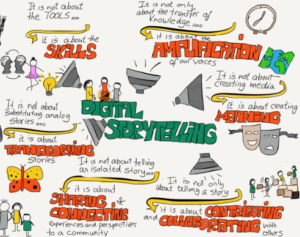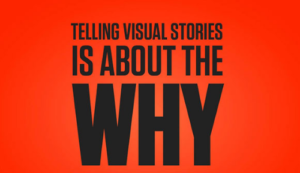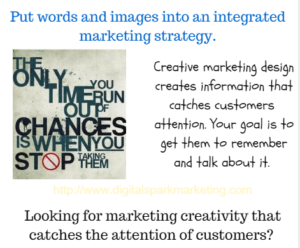Many business people have already discovered demonstrating exceptional stories and storytelling examples in a practical sense. They have observed how compelling examples can be. But recent scientific work is putting a much finer point on just how stories change our attitudes, beliefs, and behaviors.

As social creatures, we depend on others for our survival and happiness.
In subsequent studies, we have been able to deepen our understanding of why stories motivate voluntary cooperation. We discovered that to motivate a desire to help others, a story must first sustain attention – a scarce resource in the brain – by developing tension during the narrative.
If the story can create that tension, then it is likely that attentive viewers/listeners will come to share the emotions of the characters in it. After it ends, it is likely to continue mimicking the feelings and behaviors of those characters.
My research has also shown that stories are useful inside organizations. We know that people are substantially more motivated by their organization’s transcendent purpose (how it improves lives) than by its transactional purpose (how it sells goods and services).
The transcendent purpose is effectively communicated through stories. For example, by describing the pitiable situations of actual, named customers and how their problems were solved by your efforts.
Make your people empathize with the pain the customer experienced, and they will also feel the pleasure of its resolution. This would be all the more if some heroics went into reducing suffering or struggle or producing joy.
These are the stories that, repeated over and over, stay core to the organization’s DNA. They guide daily decision-making as well as the motivation that comes with the conviction that the organization’s work.
We tell stories to our coworkers and peers all the time, to explain to an employee how he might improve, or to inspire a team that is facing challenges. It’s an essential skill, but what makes a compelling story in a business context? And how can you improve your ability to tell stories that persuade?
Stories create “sticky” memories by attaching emotions to things that happen. That means leaders who can create and share good stories have a powerful advantage over others. And fortunately, everyone can become a better storyteller.

Start with a message
Every storytelling exercise should begin by asking: Who is my audience and what is the message I want to share with them? Each decision about your story should flow from those questions. I feel that leaders should ask, “What is the core moral that I’m trying to implant in my team?” and “How can I boil that down to a compelling single statement?”
For instance, if your team is behaving as if failure is not an option, you might decide to impart the message that failure is the grandfather of success.
Or if you are trying to convince senior leaders to take a risk by supporting your project, you could convey that most companies are built on taking smart chances.
First, settle on your ultimate message; then you can figure out the best way to illustrate it.
Stories and storytelling examples … mind your experiences
The best storytellers look to their memories and life experiences for ways to illustrate their message. What events in your life make you believe in the idea you are trying to share?
Think of a moment in which your failures led to success in your career or a lesson that a parent or mentor imparted. Any of these things can be interesting emotional entry points to a story. The key is to show your vulnerability.
Don’t make yourself the hero
Don’t make yourself the star of your own story. You can be a central figure, but the ultimate focus should be on people you know, lessons you’ve learned, or events you’ve witnessed.
And whenever possible, you should endeavor to make the audience or employees the hero. It increases their engagement and willingness to buy into your message.
Stories and storytelling examples … keep it simple

Not every story you tell has to be a surprising, edge-of-your-seat epic. Some of the most successful and memorable stories are relatively simple and straightforward. Don’t let needless details to detract from your core message. Work from the principle that “less is more.”
One of the biggest mistakes you can make is putting in too much detail. Don’t tell your audience what day of the week it was, for instance, or what shoes you were wearing if it doesn’t advance the story.
But transporting your audience with a few interesting, well-placed details — how you felt, the expression on a face, the humble beginnings of a now-great company — can help immerse your listeners and drive home your message.
Highlight a struggle
A story without a challenge simply isn’t very interesting.Good storytellers understand that a story needs conflict. Don’t be afraid to suggest the road ahead will be difficult. Smart leaders tell employees: This is going to be tough. But if we all pull together and hang in there, we’ll achieve something amazing in the end.”
Practice makes perfect
Storytelling is a real art form that requires repeated effort to get right. Practice with friends, loved ones, and trusted colleagues to hone your message into the most effective and efficient story. And remember that the rewards can be immense.
Example #1: Embed conflict to motivate and inspire
Bob Thompson was worried his employees were becoming complacent. Then an executive, he had seen his company become the dominant leader in the online promotions industry almost overnight. In the mid-2000s, we had double and triple growth every year. He became worried that we would start clinging to our previous success instead of forging new success, and that our creativity would decline.
So he made up a fake nemesis. At an all-company meeting, he stood up and announced that there was a brash new competitor named Noname. I told everyone they were bigger than us, faster than us, and more profitable. Their investors had deeper pockets. Their footprint was better, and they were innovating at a pace I’d never seen.
The story was greeted with chuckles around the room (it was obvious the company was a ruse), but the idea soon became embedded within the culture.
Executives kept reinforcing the Noname story with fake press releases about their competitor’s impressive quarterly earnings or infusions of capital. Soon the urge to best the imaginary rival began to drive improved performance.
It inspired creativity. In brainstorming sessions, we used Noname as the foil. I would say, ‘The folks over at Noname just shaved two days out of their cycle time. How do you think they did it?’
The whiteboards filled with ideas.
Example #2: Anchor the story in your personal experiences
Vince tells clients he knows exactly when his career direction snapped into focus. It was at his first job out of college, with an organization that helped needy individuals get back on their feet. Vince loved the mission but found the atmosphere uninspiring.
Everyone just went through the motions. I remember thinking, is this it? Is this what working in the real world is like?”
A senior manager named Smarty sensed that Vince wanted to have a bigger impact, and asked him to join several like-minded colleagues on a committee to make their workplace a more positive environment.
They began to make subtle changes, and coworkers’ attitudes started to improve. Vince saw firsthand how a single manager could change the culture of a place.
Then Smarty was diagnosed with aggressive lung cancer. In her absence, the office culture began to revert. On a visit to see her in the hospital, Vince told her about the disappointing turn of events.
She surprised him with a confession: Since she had never smoked and had no history of cancer in her family, she was convinced that her disease was a direct function of putting up with a toxic work environment for so long.
Shortly after, Smarty sent Vince a letter telling him he would be faced with an important choice throughout his life. He could allow the negative attitudes of others to influence his behavior. Or he could pursue professional goals because of the sense of personal accomplishment they offered. She was a mentor to me even though she didn’t need to be.
Two weeks later, Smarty passed away. But the letter changed Vince’s life, inspiring him to leave his job and start his own consulting business devoted to helping people be better leaders.
I’ve seen the kind of climate and culture that a great leader can create. For the last 25 years, I’ve tried to emulate that. He still has Smarty’s letter.
When Vince first began sharing this story with his leadership clients, he was taken aback by their reaction. There was a connection they had to me that was surprising. It’s like they got me in ways that I wasn’t able to directly communicate.
The bottom line
To be effective in this new era, we as marketers need to see our jobs differently. No more just focusing on metrics like clicks, video views, or social media shares. We must successfully integrate our function with other business functions to create entire brand experiences that serve the customer all the way through their experiences throughout the business.
We can do better. Much better. But first, we need to stop seeing ourselves as crafters of clever brand messages and become creators of positive brand experiences.

All you get is what you bring to the fight. And that fight gets better every day you learn and apply new ideas.
When things are not what you want them to be, what’s most important is your next step.
Test. Learn. Improve. Repeat.
Are you devoting enough energy to innovating your social media strategyg?
Do you have a lesson about making your advertising better you can share with this community? Have any questions or comments to add in the section below?
Digital Spark Marketing will stretch your thinking and your ability to adapt to change. We also provide some fun and inspiration along the way.
More leadership material from Digital Spark Marketing’s Library:
Build an Effective Team by Being a Talent Hound
Success Enablers of Highly Creative Leaders
Secrets to Becoming a Remarkably Mindful Leader
Leadership Characteristics That Improve Influence |